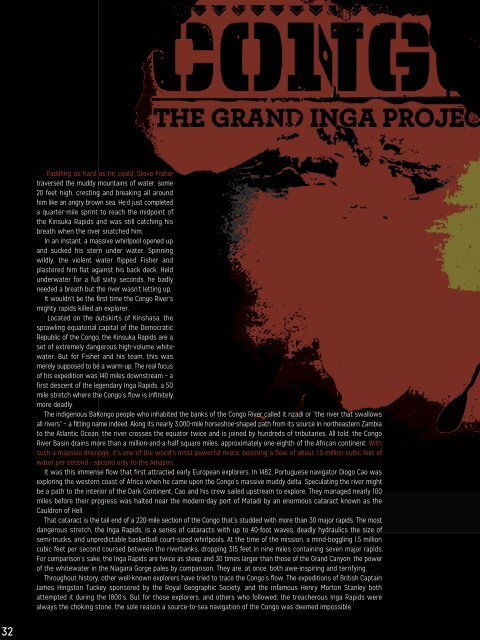River Karma
Typography project: Curated a typographic system that can be applied to various issues and structural spreads successfully where content influences the overall style and reading experience. Self created concept that focuses on grid and typographic hierarchy development pulling all articles and photographic sources from existing publications.
Typography project: Curated a typographic system that can be applied to various issues and structural spreads successfully where content influences the overall style and reading experience. Self created concept that focuses on grid and typographic hierarchy development pulling all articles and photographic sources from existing publications.
You also want an ePaper? Increase the reach of your titles
YUMPU automatically turns print PDFs into web optimized ePapers that Google loves.
32<br />
Paddling as hard as he could, Steve Fisher<br />
traversed the muddy mountains of water, some<br />
20 feet high, cresting and breaking all around<br />
him like an angry brown sea. He’d just completed<br />
a quarter-mile sprint to reach the midpoint of<br />
the Kinsuka Rapids and was still catching his<br />
breath when the river snatched him.<br />
In an instant, a massive whirlpool opened up<br />
and sucked his stern under water. Spinning<br />
wildly, the violent water flipped Fisher and<br />
plastered him flat against his back deck. Held<br />
underwater for a full sixty seconds, he badly<br />
needed a breath but the river wasn’t letting up.<br />
It wouldn’t be the first time the Congo <strong>River</strong>’s<br />
mighty rapids killed an explorer.<br />
Located on the outskirts of Kinshasa, the<br />
sprawling equatorial capital of the Democratic<br />
Republic of the Congo, the Kinsuka Rapids are a<br />
set of extremely dangerous high-volume whitewater.<br />
But for Fisher and his team, this was<br />
merely supposed to be a warm-up. The real focus<br />
of his expedition was 140 miles downstream – a<br />
first descent of the legendary Inga Rapids, a 50<br />
mile stretch where the Congo’s flow is infinitely<br />
more deadly.<br />
The indigenous BaKongo people who inhabited the banks of the Congo <strong>River</strong> called it nzadi or “the river that swallows<br />
all rivers” – a fitting name indeed. Along its nearly 3,000-mile horseshoe-shaped path from its source in northeastern Zambia<br />
to the Atlantic Ocean, the river crosses the equator twice and is joined by hundreds of tributaries. All told, the Congo<br />
<strong>River</strong> Basin drains more than a million-and-a-half square miles, approximately one-eighth of the African continent. With<br />
such a massive drainage, it’s one of the world’s most powerful rivers, boasting a flow of about 1.5 million cubic feet of<br />
water per second - second only to the Amazon.<br />
It was this immense flow that first attracted early European explorers. In 1482, Portuguese navigator Diogo Cao was<br />
exploring the western coast of Africa when he came upon the Congo’s massive muddy delta. Speculating the river might<br />
be a path to the interior of the Dark Continent, Cao and his crew sailed upstream to explore. They managed nearly 100<br />
miles before their progress was halted near the modern-day port of Matadi by an enormous cataract known as the<br />
Cauldron of Hell.<br />
That cataract is the tail end of a 220-mile section of the Congo that’s studded with more than 30 major rapids. The most<br />
dangerous stretch, the Inga Rapids, is a series of cataracts with up to 40-foot waves, deadly hydraulics the size of<br />
semi-trucks, and unpredictable basketball court-sized whirlpools. At the time of the mission, a mind-boggling 1.5 million<br />
cubic feet per second coursed between the riverbanks, dropping 315 feet in nine miles containing seven major rapids.<br />
For comparison’s sake, the Inga Rapids are twice as steep and 30 times larger than those of the Grand Canyon; the power<br />
of the whitewater in the Niagara Gorge pales by comparison. They are, at once, both awe-inspiring and terrifying.<br />
Throughout history, other well-known explorers have tried to trace the Congo’s flow. The expeditions of British Captain<br />
James Hingston Tuckey sponsored by the Royal Geographic Society, and the infamous Henry Morton Stanley both<br />
attempted it during the 1800’s. But for those explorers, and others who followed, the treacherous Inga Rapids were<br />
always the choking stone, the sole reason a source-to-sea navigation of the Congo was deemed impossible.


